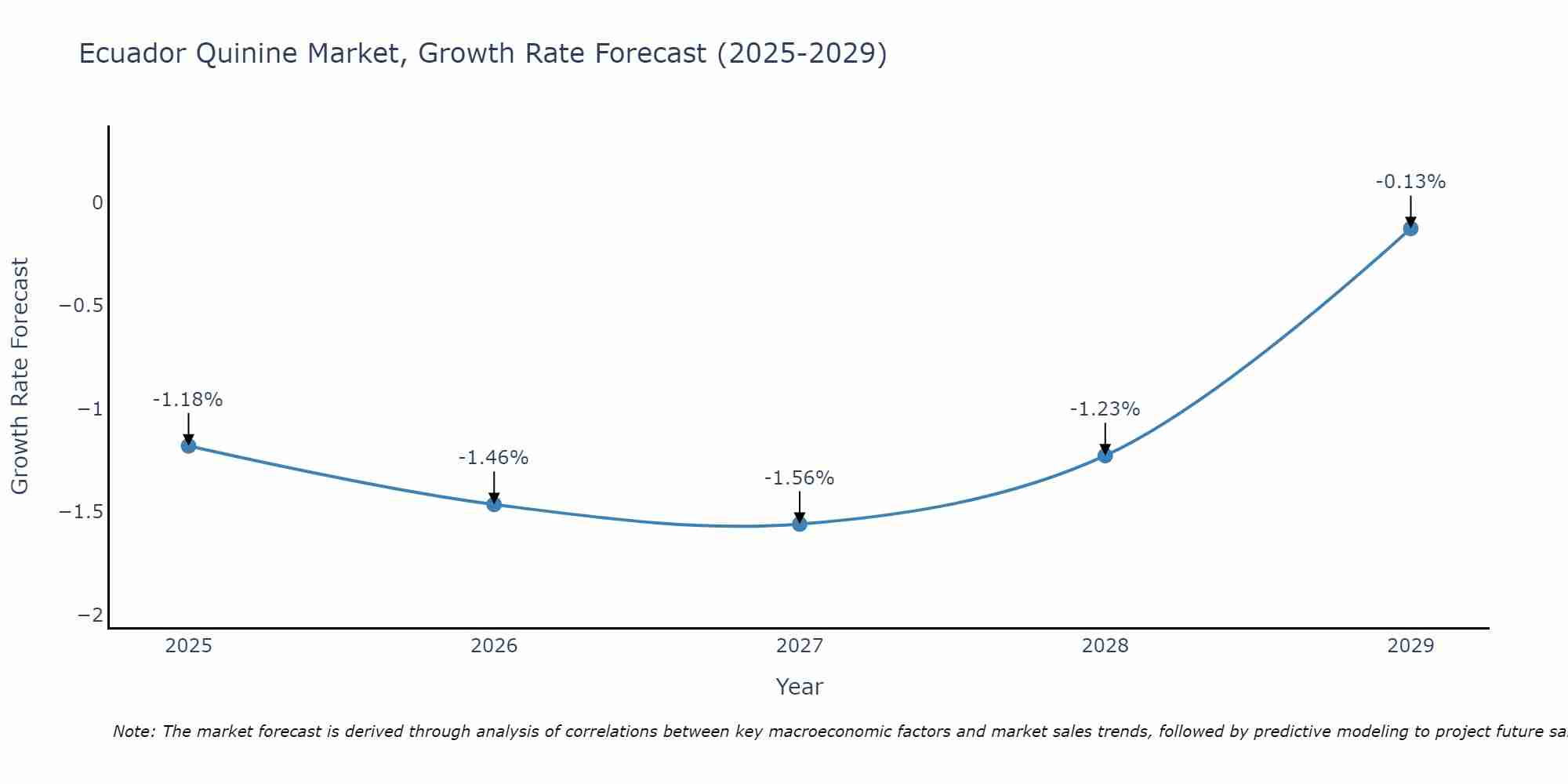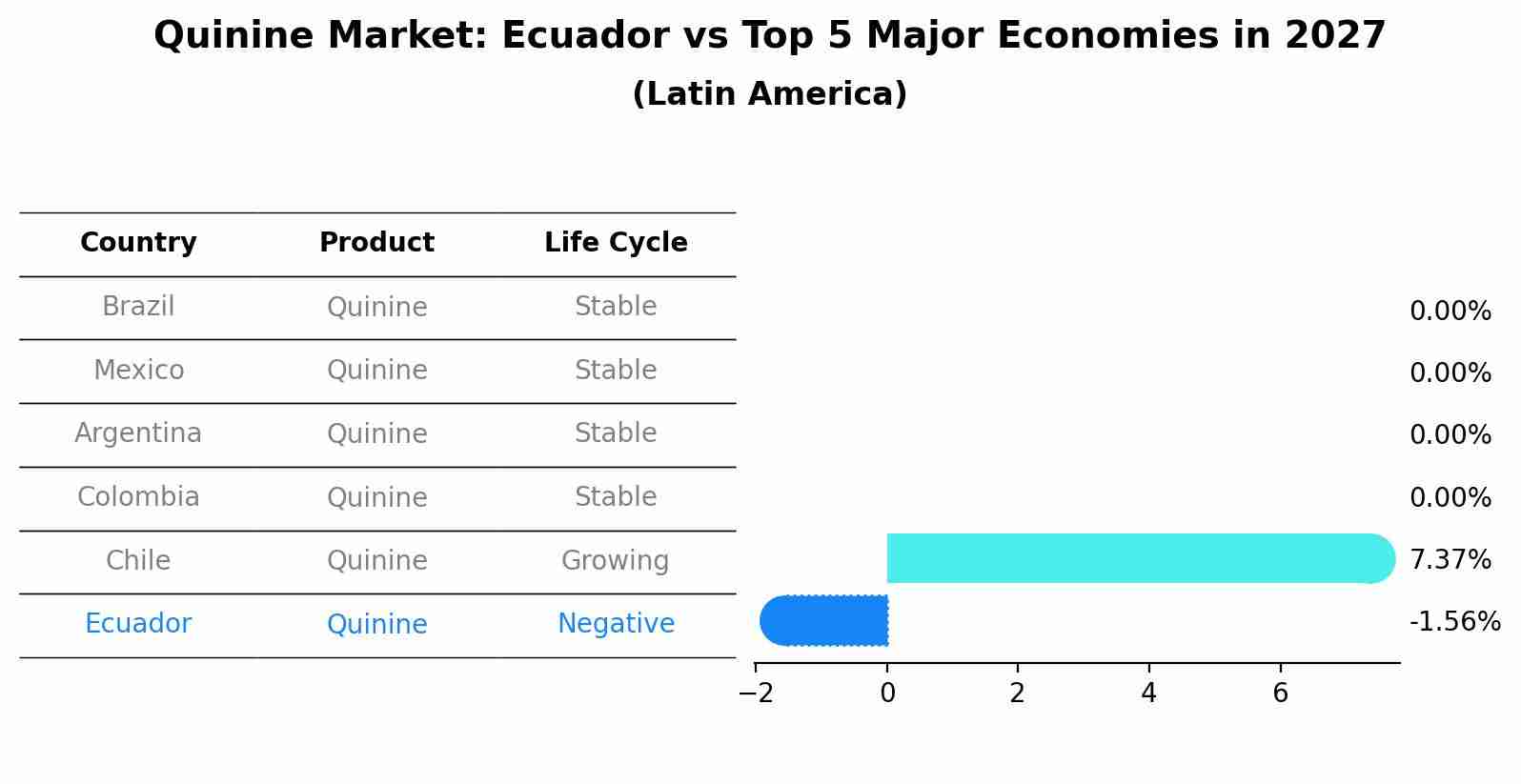Ecuador Quinine Market (2025-2031) | Revenue, Forecast, Value, Industry, Analysis, Outlook, Trends, Share, Growth, Companies, Size & Segmentation
| Product Code: ETC5312447 | Publication Date: Nov 2023 | Updated Date: Aug 2025 | Product Type: Market Research Report | |
| Publisher: 6Wresearch | Author: Bhawna Singh | No. of Pages: 60 | No. of Figures: 30 | No. of Tables: 5 |
Ecuador Quinine Market Size Growth Rate
The Ecuador Quinine Market is projected to witness mixed growth rate patterns during 2025 to 2029. Commencing at -1.18% in 2025, growth builds up to -0.13% by 2029.

Quinine Market: Ecuador vs Top 5 Major Economies in 2027 (Latin America)
The Quinine market in Ecuador is projected to grow at a negative growth rate of -1.56% by 2027, within the Latin America region led by Brazil, along with other countries like Mexico, Argentina, Colombia and Chile, collectively shaping a dynamic and evolving market environment driven by innovation and increasing adoption of emerging technologies.

Ecuador Quinine Market Overview
The Quinine Market in Ecuador is primarily driven by the pharmaceutical industry`s demand for this alkaloid, traditionally used in treating malaria. Despite the global decline in malaria incidence, quinine remains significant in treating severe cases and as a preventive measure. The local production of quinine is supported by the cultivation of cinchona trees, which are essential for extracting this compound. The market is influenced by regulatory policies related to drug approval and the increasing focus on research for alternative therapies, which could impact future demand.
Drivers of the market
The quinine market in Ecuador is primarily driven by its demand in the pharmaceutical industry, particularly for the treatment of malaria. As malaria remains a significant health concern in tropical regions, including parts of Ecuador, the need for effective treatments continues to rise. Additionally, the growing interest in natural and herbal medicines has led to a resurgence in the use of quinine sourced from cinchona bark, which is native to the region. Increased awareness of the therapeutic properties of quinine, coupled with ongoing research into its applications, is expected to drive market growth. Furthermore, the rising prevalence of malaria and other related diseases reinforces the importance of quinine in public health strategies.
Challenges of the market
The Ecuador quinine market faces challenges due to its reliance on a limited number of suppliers, which can create supply chain vulnerabilities. Quinine, used in the treatment of malaria, faces competition from synthetic alternatives and treatments that are more cost-effective or easier to distribute. Additionally, there are issues with inconsistent quality and regulatory barriers that make production and export processes complicated. Farmers and manufacturers also face difficulties related to climate change, which can affect the cultivation of the plants used to extract quinine, resulting in price fluctuations and supply shortages.
Government Policy of the market
The Ecuador Quinine Market is primarily driven by the pharmaceutical industry`s demand for quinine in the treatment of malaria. The government`s health policies, including those focused on malaria control and prevention, have significantly shaped the market. Ecuador`s Ministry of Health has been involved in initiatives to combat malaria, particularly in the Amazon and coastal regions, where the disease remains prevalent. The country`s health policies ensure access to essential medicines, including quinine, through national health programs. Ecuador also promotes research and development in tropical medicine, which supports the quinine market`s growth.
Key Highlights of the Report:
- Ecuador Quinine Market Outlook
- Market Size of Ecuador Quinine Market, 2024
- Forecast of Ecuador Quinine Market, 2031
- Historical Data and Forecast of Ecuador Quinine Revenues & Volume for the Period 2021-2031
- Ecuador Quinine Market Trend Evolution
- Ecuador Quinine Market Drivers and Challenges
- Ecuador Quinine Price Trends
- Ecuador Quinine Porter`s Five Forces
- Ecuador Quinine Industry Life Cycle
- Historical Data and Forecast of Ecuador Quinine Market Revenues & Volume By Mode of Administration for the Period 2021-2031
- Historical Data and Forecast of Ecuador Quinine Market Revenues & Volume By Oral Administration for the Period 2021-2031
- Historical Data and Forecast of Ecuador Quinine Market Revenues & Volume By Intravenous Administration for the Period 2021-2031
- Historical Data and Forecast of Ecuador Quinine Market Revenues & Volume By Intramuscular Administration for the Period 2021-2031
- Historical Data and Forecast of Ecuador Quinine Market Revenues & Volume By Others for the Period 2021-2031
- Historical Data and Forecast of Ecuador Quinine Market Revenues & Volume By Application for the Period 2021-2031
- Historical Data and Forecast of Ecuador Quinine Market Revenues & Volume By Antimalarial for the Period 2021-2031
- Historical Data and Forecast of Ecuador Quinine Market Revenues & Volume By Antipyretic for the Period 2021-2031
- Historical Data and Forecast of Ecuador Quinine Market Revenues & Volume By Others for the Period 2021-2031
- Historical Data and Forecast of Ecuador Quinine Market Revenues & Volume By End-user for the Period 2021-2031
- Historical Data and Forecast of Ecuador Quinine Market Revenues & Volume By Hospitals for the Period 2021-2031
- Historical Data and Forecast of Ecuador Quinine Market Revenues & Volume By Clinics for the Period 2021-2031
- Historical Data and Forecast of Ecuador Quinine Market Revenues & Volume By Ambulatory Surgical Centers for the Period 2021-2031
- Historical Data and Forecast of Ecuador Quinine Market Revenues & Volume By Others for the Period 2021-2031
- Ecuador Quinine Import Export Trade Statistics
- Market Opportunity Assessment By Mode of Administration
- Market Opportunity Assessment By Application
- Market Opportunity Assessment By End-user
- Ecuador Quinine Top Companies Market Share
- Ecuador Quinine Competitive Benchmarking By Technical and Operational Parameters
- Ecuador Quinine Company Profiles
- Ecuador Quinine Key Strategic Recommendations
Frequently Asked Questions About the Market Study (FAQs):
1 Executive Summary |
2 Introduction |
2.1 Key Highlights of the Report |
2.2 Report Description |
2.3 Market Scope & Segmentation |
2.4 Research Methodology |
2.5 Assumptions |
3 Ecuador Quinine Market Overview |
3.1 Ecuador Country Macro Economic Indicators |
3.2 Ecuador Quinine Market Revenues & Volume, 2021 & 2031F |
3.3 Ecuador Quinine Market - Industry Life Cycle |
3.4 Ecuador Quinine Market - Porter's Five Forces |
3.5 Ecuador Quinine Market Revenues & Volume Share, By Mode of Administration, 2021 & 2031F |
3.6 Ecuador Quinine Market Revenues & Volume Share, By Application, 2021 & 2031F |
3.7 Ecuador Quinine Market Revenues & Volume Share, By End-user, 2021 & 2031F |
4 Ecuador Quinine Market Dynamics |
4.1 Impact Analysis |
4.2 Market Drivers |
4.2.1 Increasing demand for natural and plant-based remedies |
4.2.2 Growing awareness about the health benefits of quinine |
4.2.3 Expansion of the pharmaceutical and healthcare industries in Ecuador |
4.3 Market Restraints |
4.3.1 Fluctuating prices of quinine |
4.3.2 Regulatory challenges and compliance requirements |
4.3.3 Competition from synthetic alternatives in the market |
5 Ecuador Quinine Market Trends |
6 Ecuador Quinine Market Segmentations |
6.1 Ecuador Quinine Market, By Mode of Administration |
6.1.1 Overview and Analysis |
6.1.2 Ecuador Quinine Market Revenues & Volume, By Oral Administration, 2021-2031F |
6.1.3 Ecuador Quinine Market Revenues & Volume, By Intravenous Administration, 2021-2031F |
6.1.4 Ecuador Quinine Market Revenues & Volume, By Intramuscular Administration, 2021-2031F |
6.1.5 Ecuador Quinine Market Revenues & Volume, By Others, 2021-2031F |
6.2 Ecuador Quinine Market, By Application |
6.2.1 Overview and Analysis |
6.2.2 Ecuador Quinine Market Revenues & Volume, By Antimalarial, 2021-2031F |
6.2.3 Ecuador Quinine Market Revenues & Volume, By Antipyretic, 2021-2031F |
6.2.4 Ecuador Quinine Market Revenues & Volume, By Others, 2021-2031F |
6.3 Ecuador Quinine Market, By End-user |
6.3.1 Overview and Analysis |
6.3.2 Ecuador Quinine Market Revenues & Volume, By Hospitals, 2021-2031F |
6.3.3 Ecuador Quinine Market Revenues & Volume, By Clinics, 2021-2031F |
6.3.4 Ecuador Quinine Market Revenues & Volume, By Ambulatory Surgical Centers, 2021-2031F |
6.3.5 Ecuador Quinine Market Revenues & Volume, By Others, 2021-2031F |
7 Ecuador Quinine Market Import-Export Trade Statistics |
7.1 Ecuador Quinine Market Export to Major Countries |
7.2 Ecuador Quinine Market Imports from Major Countries |
8 Ecuador Quinine Market Key Performance Indicators |
8.1 Percentage increase in the cultivation area of quinine plants in Ecuador |
8.2 Number of new product launches containing quinine |
8.3 Growth in the number of research studies highlighting the health benefits of quinine |
9 Ecuador Quinine Market - Opportunity Assessment |
9.1 Ecuador Quinine Market Opportunity Assessment, By Mode of Administration, 2021 & 2031F |
9.2 Ecuador Quinine Market Opportunity Assessment, By Application, 2021 & 2031F |
9.3 Ecuador Quinine Market Opportunity Assessment, By End-user, 2021 & 2031F |
10 Ecuador Quinine Market - Competitive Landscape |
10.1 Ecuador Quinine Market Revenue Share, By Companies, 2024 |
10.2 Ecuador Quinine Market Competitive Benchmarking, By Operating and Technical Parameters |
11 Company Profiles |
12 Recommendations | 13 Disclaimer |
- Single User License$ 1,995
- Department License$ 2,400
- Site License$ 3,120
- Global License$ 3,795
Search
Thought Leadership and Analyst Meet
Our Clients
Related Reports
- Canada Oil and Gas Market (2026-2032) | Share, Segmentation, Value, Industry, Trends, Forecast, Analysis, Size & Revenue, Growth, Competitive Landscape, Outlook, Companies
- Germany Breakfast Food Market (2026-2032) | Industry, Share, Growth, Size, Companies, Value, Analysis, Revenue, Trends, Forecast & Outlook
- Australia Briquette Market (2025-2031) | Growth, Size, Revenue, Forecast, Analysis, Trends, Value, Share, Industry & Companies
- Vietnam System Integrator Market (2025-2031) | Size, Companies, Analysis, Industry, Value, Forecast, Growth, Trends, Revenue & Share
- ASEAN and Thailand Brain Health Supplements Market (2025-2031) | Strategy, Consumer Insights, Analysis, Investment Trends, Opportunities, Growth, Size, Share, Industry, Revenue, Segments, Value, Segmentation, Supply, Forecast, Restraints, Outlook, Competition, Drivers, Trends, Demand, Pricing Analysis, Competitive, Strategic Insights, Companies, Challenges
- ASEAN Bearings Market (2025-2031) | Strategy, Consumer Insights, Analysis, Investment Trends, Opportunities, Growth, Size, Share, Industry, Revenue, Segments, Value, Segmentation, Supply, Forecast, Restraints, Outlook, Competition, Drivers, Trends, Demand, Pricing Analysis, Competitive, Strategic Insights, Companies, Challenges
- Europe Flooring Market (2025-2031) | Outlook, Share, Industry, Trends, Forecast, Companies, Revenue, Size, Analysis, Growth & Value
- Saudi Arabia Manlift Market (2025-2031) | Outlook, Size, Growth, Trends, Companies, Industry, Revenue, Value, Share, Forecast & Analysis
- Uganda Excavator, Crane, and Wheel Loaders Market (2025-2031) | Strategy, Consumer Insights, Analysis, Investment Trends, Opportunities, Growth, Size, Share, Industry, Revenue, Segments, Value, Segmentation, Supply, Forecast, Restraints, Outlook, Competition, Drivers, Trends, Demand, Pricing Analysis, Competitive, Strategic Insights, Companies, Challenges
- Rwanda Excavator, Crane, and Wheel Loaders Market (2025-2031) | Strategy, Consumer Insights, Analysis, Investment Trends, Opportunities, Growth, Size, Share, Industry, Revenue, Segments, Value, Segmentation, Supply, Forecast, Restraints, Outlook, Competition, Drivers, Trends, Demand, Pricing Analysis, Competitive, Strategic Insights, Companies, Challenges
Industry Events and Analyst Meet
Whitepaper
- Middle East & Africa Commercial Security Market Click here to view more.
- Middle East & Africa Fire Safety Systems & Equipment Market Click here to view more.
- GCC Drone Market Click here to view more.
- Middle East Lighting Fixture Market Click here to view more.
- GCC Physical & Perimeter Security Market Click here to view more.
6WResearch In News
- Doha a strategic location for EV manufacturing hub: IPA Qatar
- Demand for luxury TVs surging in the GCC, says Samsung
- Empowering Growth: The Thriving Journey of Bangladesh’s Cable Industry
- Demand for luxury TVs surging in the GCC, says Samsung
- Video call with a traditional healer? Once unthinkable, it’s now common in South Africa
- Intelligent Buildings To Smooth GCC’s Path To Net Zero


















